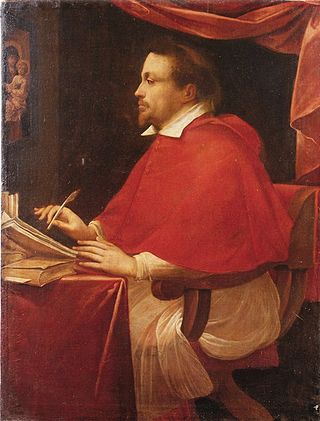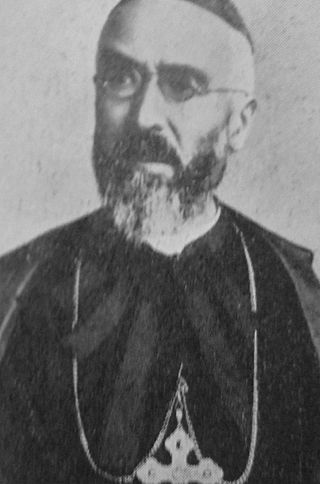
Angelo Maria Bandini was an Italian author and librarian born in Florence.

The Ambrosian Rite is a Latin liturgical rite of the Catholic Church. The rite is named after Saint Ambrose, a bishop of Milan in the fourth century. It is used by around five million Catholics in the greater part of the Archdiocese of Milan, in some parishes of the Diocese of Como, Bergamo, Novara, Lodi, and in the Diocese of Lugano, Canton of Ticino, Switzerland.

The Ambrosian Iliad or Ilias Picta is a 5th-century illuminated manuscript on vellum, which depicts the entirety of Homer's Iliad, including battle scenes and noble scenes. It is considered unique due to being the only set of ancient illustrations that depict scenes from the Iliad. The Ambrosian Iliad consists of 52 miniatures, each labeled numerically. It is thought to have been created in Alexandria, given the flattened and angular Hellenistic figures, which are considered typical of Alexandrian art in late antiquity, in approximately 500 AD, possibly by multiple artists. The author(s) first drew the figures nude and then painted the clothes on, much like in Greek vase painting. In the 11th century, the miniatures were cut out of the original manuscript and pasted into a Siculo-Calabrian codex of Homeric texts.

Federico Borromeo was an Italian cardinal and Archbishop of Milan, a prominent figure of Counter-Reformation in Italy. Federico was a hero of the plague of 1630, described in Alessandro Manzoni's historical novel, The Betrothed. He was a great patron of the arts and founded the Biblioteca Ambrosiana, one of the first free public libraries in Europe. In 1618 he added a picture gallery, donating his own considerable collection of paintings. His published works, mainly in Latin, number over 100. They show his interest in ecclesiastical archaeology, sacred painting, and collecting.
Antonio Maria Ceriani was an Italian prelate, Syriacist, and scholar.

The Codex Atlanticus is a 12-volume, bound set of drawings and writings by Leonardo da Vinci, the largest single set. Its name indicates the large paper used to preserve original Leonardo notebook pages, which was used for atlases. It comprises 1,119 leaves dating from 1478 to 1519, the contents covering a great variety of subjects, from flight to weaponry to musical instruments and from mathematics to botany. This codex was gathered in the late 16th century by the sculptor Pompeo Leoni, who dismembered some of Leonardo's notebooks in its formation. It is now in the Biblioteca Ambrosiana in Milan.

Giovanni Mercati was an Italian cardinal of the Roman Catholic Church. He served as archivist of the Vatican Secret Archives and librarian of the Vatican Library from 1936 until his death, and was elevated to the cardinalate in 1936.
Uncial 0135, ε 85 (Soden), is a Greek uncial manuscript of the New Testament, dated paleographically to the 9th century.
Minuscule 345, ε 119 (Soden), is a Greek minuscule manuscript of the New Testament, on parchment. Paleographically it has been assigned to the 11th century. The manuscript was prepared for Church reading. It has full marginalia.
Minuscule 350, ε 122 (Soden), is a Greek minuscule manuscript of the New Testament, on parchment. Paleographically it has been assigned to the 11th century. It has marginalia.

Minuscule 348, ε 227 (Soden), is a Greek minuscule manuscript of the New Testament, on parchment. Dated by a colophon to the year 1022 . It has full marginalia.
Minuscule 349, ε 413 (Soden), is a Greek minuscule manuscript of the New Testament, on paper. It is dated by a colophon to the year 1322. It has marginalia.
Minuscule 351, ε 228 (Soden), is a Greek minuscule manuscript of the New Testament, on parchment. Paleographically it has been assigned to the 12th century. It has marginalia.
Minuscule 352, ε 123 (Soden), is a Greek minuscule manuscript of the New Testament, on parchment. Paleographically it has been assigned to the 11th century. It has marginalia.
Minuscule 588, ε 229, is a Greek minuscule manuscript of the New Testament, on parchment. It is dated by a colophon to the year 1321. The manuscript is lacunose. It was labelled by Scrivener as 457.
Minuscule 615, α 560, is a Greek minuscule manuscript of the New Testament, on paper. Palaeographically it has been assigned to the 15th century. Tischendorf labeled it by 138a and 173p.

Minuscule 832 (in the Gregory-Aland numbering), A127 (von Soden), is a 10th-century Greek minuscule manuscript of the New Testament on parchment. The manuscript has no complex contents.

Minuscule 836, Θε46, is a 14th-century Greek minuscule manuscript of the New Testament on paper. The manuscript is not complete, it lacks Gospel of Luke.

The ms. Ambrosiano O 39 sup. – is a manuscript of the Hexapla of Origen dated to the late ninth century C.E. written in a codex form. This is a palimpsest, meaning that the current text is written on leaves which had been written on before and cleaned.
Giuseppe Antonio Sassi, Latin: Saxius, was an Italian librarian and literary scholar.















